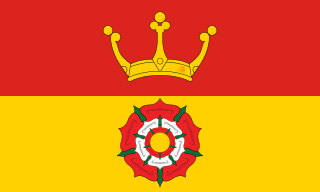
Hampshire is a county in South East England on the English Channel coast. The county town is Winchester, England's former capital city. Its two largest cities, Southampton and Portsmouth, are administered separately as unitary authorities and the rest of the county is governed by a combination of Hampshire County Council and non-metropolitan borough councils.

Winchester is a cathedral city in Hampshire, England. The city lies at the heart of the wider City of Winchester, a local government district, at the western end of the South Downs National Park, on the River Itchen. It is 60 miles (97 km) south-west of London and 14 miles (23 km) from Southampton, the closest other city. At the 2011 census, Winchester had a population of 45,184. The wider City of Winchester district, which includes towns such as Alresford and Bishop's Waltham, has a population of 116,595. Winchester is the county town of Hampshire and contains the head offices of Hampshire County Council.

The London Wall was a defensive wall first built by the Romans around the strategically important port town of Londinium in c. 200 CE. It has origins as an initial mound wall and ditch from c. 100 CE and an initial fort, now called Cripplegate fort after the city gate that was positioned within its northern wall later on, built in 120-150 CE where it was then expanded upon by Roman builders into a city-wide defence. Over time, as Roman influence waned through the departure of the Roman army in c. 410 CE, their withdrawal led to its disrepair, as political power on the island dispersed through the Heptarchy period of Anglo-Saxon England. From the conquest of William the Conqueror, successive medieval restorations and repairs to its use have been undertaken. This wall largely defined the boundaries of the City of London until the later Middle Ages, when population rises and the development of towns around the city blurred the perimeter.

The City of Winchester is a local government district in Hampshire, England, with a city status.

New Alresford or simply Alresford is a market town and civil parish in the City of Winchester district of Hampshire, England. It is 7.5 miles (12 km) northeast of Winchester and 12 miles (20 km) southwest of the town of Alton.
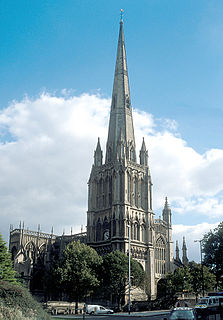
Bristol, the largest city in South West England, has an eclectic combination of architectural styles, ranging from the medieval to 20th century brutalism and beyond. During the mid-19th century, Bristol Byzantine, an architectural style unique to the city, was developed, and several examples have survived.

Wolvesey Castle, also known as the "Old Bishop's Palace", is a ruined building in Winchester, Hampshire, England that was a bishop's palace, and was briefly fortified during the later years of Henry of Blois, the Bishop of Winchester. The first building on the site, an eyot in the River Itchen known as Wulveseye or Wulf's island, was constructed around 970 by Æthelwold of Winchester, the Bishop of Winchester from 963 to 984, as his official residence or palace. Winchester came under siege during the Rout of Winchester in 1141 by the Empress Matilda during the period of civil war known as The Anarchy, and held out for three weeks until relieved by Stephen's wife, Matilda. Subsequently Henry, the brother of Stephen, King of England, enlarged and fortified the palace by building a curtain wall, giving the palace the appearance of a castle. The fortifications were slighted by Henry II after the death of Henry in 1171.

Winchester Castle is a medieval building in Winchester, Hampshire, England. It was founded in 1067. Only the Great Hall still stands; it houses a museum of the history of Winchester.

Denbigh Castle and town walls were a set of fortifications built to control the lordship of Denbigh after the conquest of Wales by King Edward I in 1282. The King granted the lands to Henry de Lacy, the Earl of Lincoln, who began to build a new walled town, colonised by immigrants from England, protected by a substantial castle and surrounded by deer parks for hunting. The work had not been completed by 1294, when the Welsh temporarily seized the castle during the Madog ap Llywelyn revolt. The defences continued to be improved, although the castle was not completely finished by the time of Henry's death in 1311.
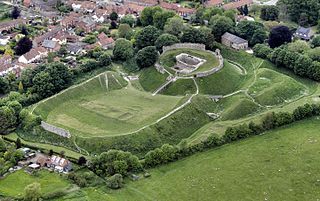
Castle Acre Castle and town walls are a set of ruined medieval defences built in the village of Castle Acre, Norfolk. The castle was built soon after the Norman Conquest by William de Warenne, the Earl of Surrey, at the intersection of the River Nar and the Peddars Way. William constructed a motte-and-bailey castle during the 1070s, protected by large earthwork ramparts, with a large country house in the centre of the motte. Soon after, a small community of Cluniac monks were given the castle's chapel in the outer bailey; under William, the second earl, the order was given land and estates to establish Castle Acre Priory alongside the castle. A deer park was created nearby for hunting.
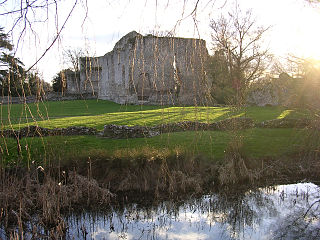
Bishop's Waltham Palace is a moated Bishop's Palace ruin in Bishop's Waltham, Hampshire, England. It is a scheduled ancient monument and a Grade II* listed building

Venta Belgarum, or Venta Bulgarum, was a town in the Roman province of Britannia Superior, the civitas capital of the local tribe, the Belgae, and which later became the city of Winchester.
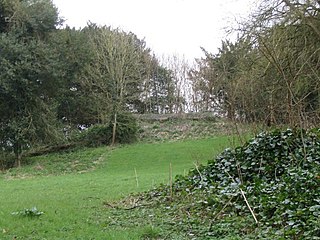
The remains of Ashley Castle are in the small village of Ashley, Test Valley, in Hampshire.

Port Way is an ancient road in southern England. Commonly associated with the Roman Empire, the road ran between Calleva Atrebatum (Silchester) and Sorbiodunum (Salisbury), but may have predated the Roman occupation of Britain.
In the Rout of Winchester the army of imprisoned King Stephen of England, led by his wife, Queen Matilda of Boulogne, Stephen's brother Bishop Henry of Blois, and William of Ypres, faced the army of Stephen's cousin Empress Matilda, whose forces were commanded by her half-brother Earl Robert of Gloucester. After Empress Matilda's army besieged a castle on the edge of Winchester, Queen Matilda's army arrived and blockaded the Angevin army within the city. Cut off from supplies, the Angevin army gave up the siege, then was crushed as it began to retreat. Robert of Gloucester was captured and was subsequently exchanged for Stephen, who was returned to the throne of England. However, the civil war known as The Anarchy dragged on with neither side gaining an advantage.

Clausentum was a small town in the Roman province of Britannia. The site is believed to be located in Bitterne, which is now a suburb of Southampton.

Worcester's city walls are a sequence of defensive structures built around the city of Worcester in England between the 1st and 17th centuries. The first walls to be built around Worcester were constructed by the Romans. These early walls lasted beyond the fall of the Empire, and the defences encouraged several early Christian foundations to establish themselves in Worcester during the troubled 6th and 7th centuries. The Anglo-Saxons expanded Worcester in the 890s, forming a new walled, planned city, called a burh. The burh utilised the southern stretches of the old Roman walls, but pushed further north to enclose a much larger area. The Anglo-Saxon city walls were maintained by a share of taxes on a local market and streets, in an agreement reinforced by a royal charter.

Southampton's town walls are a sequence of defensive structures built around the town in southern England. Although earlier Roman and Anglo-Saxon settlements around Southampton had been fortified with walls or ditches, the later walls originate with the move of the town to the current site in the 10th century. This new town was defended by banks, ditches and the natural curve of the river and coastline. The Normans built a castle in Southampton but made no attempts to improve the wider defences of the town until the early 13th century, when Southampton's growing prosperity as a trading centre and conflict with France encouraged the construction of a number of gatehouses and stone walls to the north and east sides of the settlement.

Itchen Stoke and Ovington is an English civil parish consisting of two adjoining villages in Hampshire, England, 2 miles (3.2 km) west of Alresford town centre in the valley of the River Itchen, 5 miles (8.0 km) north-east of Winchester, and 2 miles (3.2 km) south-east of Itchen Abbas.

The Storming of Farnham Castle occurred on 1 December 1642, during the early stages of the First English Civil War, when a Parliamentarian force attacked the Royalist garrison at Farnham Castle in Surrey. Sir John Denham had taken possession of the castle for the Royalists in mid-November, but after the Royalists had been turned back from London at the Battle of Turnham Green, a Parliamentarian force under the command of Sir William Waller approached the castle. After Denham refused to surrender, Waller's forces successfully stormed the castle. They captured it in under three hours, mostly due to the unwillingness of the Royalist troops to fight. This allowed the Parliamentarians to get close enough to breach the gates, after which the garrison surrendered.



















